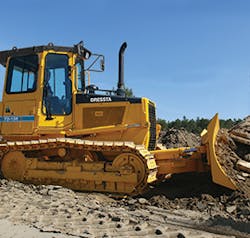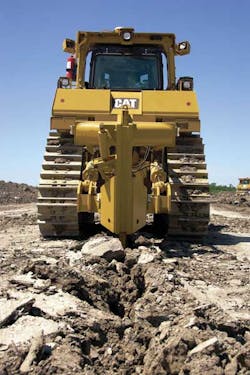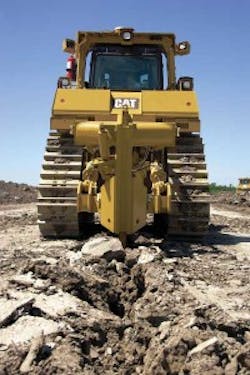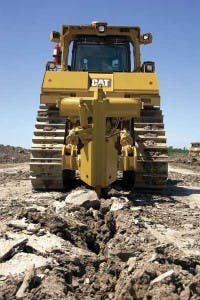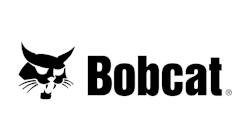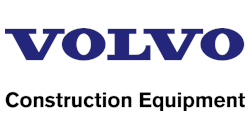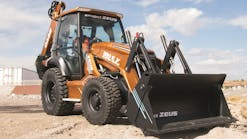Obviously, the basic key to getting the most from your dozer investment is to keep it busy. That depends on projects being available and on your estimators’ ability to bid work successfully. But upstream from the work site, an equipment dealer and manufacturer have also put in many hours to make that dozer as productive as possible.
The operator plays an important part in this process. Equipment dealers, manufacturers, and even some large contractors provide operator training, and training is a vital part of running a productive dozer. New equipment comes with an owner’s manual, and it will explain the care and feeding of your dozer.
For example, take the Komatsu D61EXi/PXi-23 dozer, the company’s first intelligent machine-control model, introduced recently to the North American market. This dozer comes from the Komatsu factory with a completely integrated GPS package for automatic blade control from first pass to final pass.
“Soil is moved efficiently and only once,” says Charles Murawski, product manager, bulldozers, Komatsu America Corp. “There are no wires, antennas or other parts to mount onto the blade or engine hood.”
While crawler dozers have been able to perform high-precision finish grading after installing an add-on machine control system, the D61i-23 can perform rough dozing as well as finish grading in automatic mode, thanks to its fully automatic blade control. When rough dozing, the automatic blade control monitors blade load and adjusts blade elevation to minimize track slip and perform high-efficiency dozing. As work progresses closer to the target finish grade, the automatic blade control adjusts to provide finish grade performance.
With the D61EXi/PXi-23, typical add-on machine-control system components mounted on the blade have been replaced with factory-installed cab-top GNSS antenna, an inertial measuring unit, and stroke-sensing hydraulic cylinders. (GNSS stands for Global Navigation Satellite System.) These components, along with the machine-control monitor and controllers mounted inside of the cab, are installed at the Komatsu factory.
“The integrated sensor package is not only robust and accurate but also eliminates the daily hassles of removing the GNSS antennas and cables from the blade, plus the wear associated with that,” says Peter Robson, director of intelligent machine controls for Komatsu.
Longer track-on-ground standard (EX) and low ground pressure (PX) models of the D61-23 are available to offer flotation and weight distribution options that best match customers’ applications. Operating weights range from 39,441 pounds to 41,381 pounds, depending on the configuration, with a net 168 horsepower at 2,200 rpm.
Hydrostatic Drive
John Deere dozers feature hydrostatic drive transmissions, notes Scott Bayless, product consultant manager for John Deere Construction and Forestry. “These transmissions provide customers high levels of production pound for pound,” says Bayless. “The automatic power management of the hydrostatic means the operator is always in the “˜sweet spot’ from an engine power perspective, without worrying about being in the wrong gear. The Deere power train also provides full control of both tracks during turns while providing a boost in engine horsepower to power through the turn. This allows the operator to carry larger blades of material without losing momentum throughout the turn.”
Bayless says that training operators is a very important part of maximizing an owner’s investment in a crawler dozer. It doesn’t matter how productive the tractor is if the operator isn’t using it to its fullest abilities. To this end, having the operator fully trained on the full capabilities of the dozer and all of its features is a key to getting the most out of a midsize crawler dozer.
The question of who performs this training depends a lot on the size and needs of the customer, says Bayless. Training can come from large customers who performing in-house training on their own, or from equipment dealers or from manufacturers. With many customers, John Deere training simulators have helped train dozer operators as well as operators of other machines. Going beyond just the basic operation of the crawler, the John Deere dozer simulator can be combined with a Topcon or Trimble system, so customers can train their operators on both the controls of the dozer and their grade-control system.
New Lineup From Case
Case Construction Equipment introduced its new line of M Series dozers in 2013. John Bauer, brand marketing manager at Case, says the M Series dozers provide best-in-class drawbar pull (force exerted after overcoming tractive resistance), which allows operators to push more material at a more consistent pace. The machines also offer one of the most robust frames in the industry, designed to withstand these drawbar pull forces.
The new M Series dozers meet current Tier 4 Interim regulations with selective catalytic reduction (SCR) technology. With this technology come increases in power and efficiency. SCR is optimal for dozers because, on a dozer, the transmission is the primary mechanism that exerts the power needed to push the load forward. As the dozer backs up to prepare for another push, the load is taken off the machine. The result is inconsistent engine loads and emissions output much like those encountered with a wheel loader.
As such, SCR is well suited for dozers because it lets the engine run at peak performance without compromising power or drawbar pull required to move material when it’s needed most. At the same time, the technology allows for significant gains in fuel efficiency, which these new M Series dozers provide in comparison with previous machines. Another major benefit of this is that it does not require the downtime associated with regeneration in cooled exhaust gas recirculation (CEGR) systems.
Bauer says Case’s new cab environment and controls are designed to provide the best in performance and comfort. Operators can select between smooth, moderate, and aggressive reversing and steering mode settings to match the machines to the ground conditions and to the driver’s preference. The cab has also been positioned farther forward to provide maximum visibility to the blade and improved machine balance, while noise levels within the cab have been reduced. The positive pressure of the cab also helps keep dust out.
As standard equipment, Case track covers have been angled to 49 degrees for improved self cleaning-very important for track health. Case Extended Life Tracks (CELT) are also available as optional equipment. These tracks deliver up to twice the life of standard lubricated tracks. The CELT track chain uses two coaxial bushings. The outer one rotates when in contact with the sprocket, greatly reducing friction wear. The sprocket features fewer teeth but has more wear material between the teeth.
New Case dozers come standard with ProCare, which is the company’s exclusive equipment management program. ProCare is a suite of product assurances, including a three-year Advanced Case SiteWatch telematics subscription, a three-year, 3,000-hour full-machine factory warranty, and a three-year, 3,000-hour planned maintenance contract.
“Stable Blade” From Caterpillar
“Many features of a Caterpillar dozer are intended to address customer needs regarding lowest owning and operating costs,” says Cat’s Dave Cusac, sales support consultant for track-type tractors. “Such features include our new Stable Blade (D3K2 to D6K2) that enables a novice operator to more easily carry a smooth finish grade. Plus, a skilled operator can use fewer blade inputs to the implement (blade joystick) control. That reduces operator fatigue.”
Cusac also notes that Cat’s AccuGrade GPS or laser system enables the operator to put the project on design grade with fewer passes using automatic blade control. “Other features include extended fluid/filter intervals and our emphasis on serviceability, where removable panels provide access to filters,” Cusac says. “And we have grouped service points to reduce the time that the machine is away from moving dirt and generating revenue for our customers.”
Cusac says Cat’s Stable Blade feature is a distinct advantage, as it brings increased productivity without the expense of automated blade control components. Other key features that Cat offers include designing the case and frame for multiple lives or rebuilds, which really helps customers realize the true value built into every Cat track-type tractor.
A Caterpillar-certified rebuilt machine has the same warranty as a new machine but at a significantly reduced cost, Cusac says. “We also incorporate technology such as AccuGrade Ready Option at the factory buildup level. This feature allows the simple integration of a GPS or Laser AccuGrade kit to the machine for the utmost customer productivity and profitability.
Hydrostatic Drive at Liebherr
Liebherr Construction Equipment markets a line of five hydrostatic-drive dozers in North America. The smallest is the PR 724, with 161 horsepower, and the largest is the PR 764, which boasts 416 horsepower.
“The biggest advantage that our customers get out of our machines is the drivetrain,” says Robert Klima, product manager for crawler tractors at Liebherr. “All our machines have hydrostatic drivetrains. Even the biggest one, like the PR 764, is a fully hydrostatic machine. Right now it’s the largest hydrostatic dozer in the world.
Klima says hydrostatic drive provides higher fuel efficiency compared to conventional drive with torque converter and powershift transmissions. “While maintaining the same productivity and performance of the machine, we have lower fuel consumption,” says Klima. “And this reduction in fuel consumption can range between 5% and 20%, depending on the application. The other benefit you have is that you can keep the engine running at a very low and constant engine speed. Most of our competitors have a maximum engine speed on the smaller machines of 2,100 to 2,200 rpm and on the larger machines between 1,800 and 1,900 rpm. On our smaller machines, we are somewhere around 1,800, and on the larger machines 1,600 rpm. We are talking about fuel savings. The other thing with the engine running at a constantly low speed is that you have less wear on the engine. When you don’t require the engine to speed up and down all the time it saves fuel. So all together that’s how we achieve a much higher efficiency of the machine.”
The Liebherr drivetrain is fully electronically controlled. “It’s a drive-by-wire system,” says Klima. “When the operator starts the engine, the pumps already start turning. They’re just not pumping any oil yet. We have flow-controlled pumps and flow-controlled motors. The travel control unit controls what we call the swashplates in the pumps, which control the flow.
All cooling systems are hydrostatic on a Liebherr dozer. The machines feature cooling-on-demand systems, even in the smaller machines. The cooling system automatically adjusts the fan speed to the temperature level of the medium: coolant, charge air, or hydraulic oil. As soon as it senses an increased temperature level, it accelerates the fan. It lets the engine or the whole machine warm up quicker, and then let it run more efficiently. It does not turn the fan at full speed all the time.
Liebherr uses a different system for all the joints to mount front attachments, such as where the push beam cylinders attach to the blade. Those are all maintenance-free connections, Klima says. “It’s like a bearing cap that’s made out of roller-bearing steel so if you ever have wear on those joints, you just replace that cap. That applies to joints on the blade, push beams, and hydraulic cylinders to the blade.”
Competitors use a system that is more like a ball-bearing, Klima says, and you have two clamps that go around that metal ball. “What our competitors use is shims in there, and once you have some wear on it, you take shims out. The problem you have with that system is you get to the point where you cannot take any shims out anymore because there’s no shims left. What you have to do then is cut it off and weld a new piece in there.
“We don’t use shims,” says Klima. “We have bearing caps in there. You can compare it to a crankshaft on an engine, where you have those half-moon bearing caps. We use a similar thing on those joints, and once this bearing cap wears out, you take the cover off, and put a new bearing cap in there, which is a very cheap part, and put it back together and that’s it.”
Dressta: Minimal Electronics
Over a year ago, Liugong Construction Machinery bought Dressta. Liugong has three product lines: Dressta dozers, Liugong Machinery, and Liugong Lift Trucks. Dressta considers it a benefit to customers to have a minimum of computerization in the design of the dozer. “We have a very basic rugged design that allows for longer component life,” says Bob Schenk, product manager for Dressta.
Dressta’s midsize dozers begin with the TD14, with 160 horsepower, and range up to the TD40, with 515 net horsepower. In between are the TD15 with 190 horsepower, the TD20 at 240 horsepower, and the TD25 with 330 horsepower. The company also offers smaller dozers.
We asked Schenk to explain the minimum of electronics. “Quite often, particularly in the competitors’ hydrostatic machines, a lot of it is drive by wire,” he says. “The computer controls many operations of the tractor. The only computers we use are a logic circuit that helps with the two-speed steering, and that’s just a simple thing that plugs in and out-and the engine computer that is needed for pollution control. That’s it. We don’t have any other computers. The downside is that electronics is what goes out on these machines, and corrosion can set in, particularly if you’re in a hostile environment.”
The Dressta dozers are built in Poland, but Schenk says they have a high percentage of North American content. “Most of our suppliers are within a 300-mile radius of Chicago, and the same is true of Caterpillar, and John Deere, and everybody else,” Schenk says. “We’re shipping parts all the time to Poland for production machines.”
On Dressta’s larger models, the three-speed transmission and two-speed steering provide the equivalent of six speeds. The operator can combine the two and effectively have six speeds forward and six in reverse. “It lets you match the tractor to the situation a lot better,” says Schenk. “And it gives you a lot of pushing ability going uphill as well.
Schenk says Dressta is covered by parts and service dealers across North America. And the company has been adding new machine dealers in the South and West since Komatsu sold Dressta in 2005. “We migrated away from each other and now we’re filling in those open areas,” says Schenk.
Maintaining Your Dozer
Deere’s Bayless says owners of midsize dozers should keep the air, oil, and grease that go into their machines clean. This starts by performing daily inspections of the machine and lubricating all grease points at the recommended intervals. At longer hour intervals, sampling and changing oils and filters helps reduce expensive repairs of major components and unplanned downtime. One preventive maintenance item that is often overlooked until the machine exhibits a problem is the inspection and cleaning of the cooling package. Depending on the environment in which a dozer is being operated, the cooling package should be inspected and cleaned anywhere from several times a day to once a month. Keeping the cooling package free of debris allows all of the critical systems on the machine to operate at the heat range for which it was designed, which helps extend the life of the tractor and its components.
Bayless says the cooling package on the midsize K-series John Deere dozers provides exclusive debris management features. The K-series dozers arrange the coolers of the cooling package in a v-shaped configuration. This eliminates stacked coolers and provides the opportunity to separate the entire cooling package from the engine compartment. This prevents the cooling package from drawing pre-heated air from the engine compartment and allows all of the air entering the cooling package to be pre-screened. This greatly improves cooling efficiency and minimizes debris entering the package increasing uptime.
Klima says Liebherr tries to keep maintenance to a minimum. “We avoid having a lot of parts that actually wear out on the machine,” he says. “Our machines don’t have any service brakes. On a conventional machine with torque converter and powershift transmission, you have to have service brakes to slow down the machine when you go downhill, or if you want to stop. On our machine we use the hydrostatic drive train to slow it down. It’s like negative engine power. If this negative engine power is not enough to slow it down, we use attachment hydraulics to create a load on the engine to slow it down. The attachment hydraulic pump creates some pressure to put a load on the engine. It keeps the engine at that constant level. The engine is constantly running at 1,600 rpms, but even at 1,600 rpms, it provides that braking power.”
Klima says Liebherr does not use sandwich coolers in its machine. “The problem you have, especially in very dusty applications, is that if you use sandwich coolers you get material stuck between the coolers. The way our cooling system is designed, it uses coolers that are either stacked above each other but not sandwiched. On the larger machines where we don’t have enough room in front of the machine to stack them above each other, we have a stacked cooling compartment on the right side of the machine.”